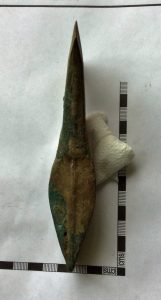PALSTAVE 773804
Description: A complete copper-alloy cast palstave type axe dating to the Acton Park II, Taunton or Penard metalworking phases of the Middle Bronze Age, c. 1550-1150 BC (Needham's metalworking phases VIII and IX). The presence of a shield-shaped depression below the stop ridge suggests that this piece corresponds to the 'Group 1; primary shield pattern' subtype. The axe is in extremely good condition, with a light brownish patina covering most of its surfaces, interspersed with areas covered by a patchy green corrosion product. In plan view, the axe is broadly sub-triangular, while being sub-lenticular/sub-lozengiform in section. The object achieves its thickest point. halfway down the flange facets where they extend high above the septum, before tapering steadily to the cutting edge, which itself is convex in plan view in addition to flaring outwards. Just below the stop ridge and septum on both sides of the palstave, there is a small shield shaped convcave depression, bordered on each side by the flange facets. A prominent ridge runs down each side of the axe, probably indicative of the original casting process. Similar palstave axes are visible in Schmidt, P. and Burgess, C. 1981. The Axes of Scotland and Northern England, pages 117-125, ref. 770-787A. A broadly comparable example on the PAS database can be found in record ESS-FB0374
Max Blade width = 66.8mm
Stop ridge length = 25mm
stop ridge width = 16mm
stop ridge thickness = 13.5mm
septum length = 65mm
septum width = 21.5mm
septum depth = 10.8mm
max thickness point = 28.5mm
Date: -1550 - -1150
Object type: PALSTAVE
Last import: September 22, 2022


